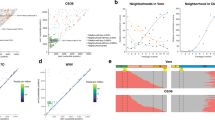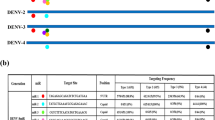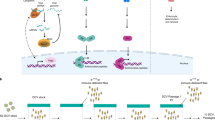Abstract
Dengue fever is the most frequent arthropod-borne viral disease of humans, with almost half of the world’s population at risk of infection1. The high prevalence, lack of an effective vaccine, and absence of specific treatment conspire to make dengue fever a global public health threat1,2. Given their compact genomes, dengue viruses (DENV-1–4) and other flaviviruses probably require an extensive number of host factors; however, only a limited number of human, and an even smaller number of insect host factors, have been identified3,4,5,6,7,8,9,10. Here we identify insect host factors required for DENV-2 propagation, by carrying out a genome-wide RNA interference screen in Drosophila melanogaster cells using a well-established 22,632 double-stranded RNA library. This screen identified 116 candidate dengue virus host factors (DVHFs). Although some were previously associated with flaviviruses (for example, V-ATPases and α-glucosidases)3,4,5,7,9,10, most of the DVHFs were newly implicated in dengue virus propagation. The dipteran DVHFs had 82 readily recognizable human homologues and, using a targeted short-interfering-RNA screen, we showed that 42 of these are human DVHFs. This indicates notable conservation of required factors between dipteran and human hosts. This work suggests new approaches to control infection in the insect vector and the mammalian host.
This is a preview of subscription content, access via your institution
Access options
Subscribe to this journal
Receive 51 print issues and online access
$199.00 per year
only $3.90 per issue
Buy this article
- Purchase on Springer Link
- Instant access to full article PDF
Prices may be subject to local taxes which are calculated during checkout




Similar content being viewed by others
Accession codes
References
Kyle, J. L. & Harris, E. Global spread and persistence of dengue. Annu. Rev. Microbiol. 62, 71–92 (2008)
Mackenzie, J. S., Gubler, D. J. & Petersen, L. R. Emerging flaviviruses: the spread and resurgence of Japanese encephalitis, West Nile and dengue viruses. Nature Med. 10, S98–S109 (2004)
Andoh, T. et al. Effect of bafilomycin A1 on the growth of Japanese encephalitis virus in Vero cells. J. Neurovirol. 4, 627–631 (1998)
Chapel, C. et al. Antiviral effect of α-glucosidase inhibitors on viral morphogenesis and binding properties of hepatitis C virus-like particles. J. Gen. Virol. 87, 861–871 (2006)
Courageot, M. P., Frenkiel, M. P., Dos Santos, C. D., Deubel, V. & Despres, P. α-glucosidase inhibitors reduce dengue virus production by affecting the initial steps of virion morphogenesis in the endoplasmic reticulum. J. Virol. 74, 564–572 (2000)
Emara, M. M. & Brinton, M. A. Interaction of TIA-1/TIAR with West Nile and dengue virus products in infected cells interferes with stress granule formation and processing body assembly. Proc. Natl Acad. Sci. USA 104, 9041–9046 (2007)
Heinz, F. X. et al. Structural changes and functional control of the tick-borne encephalitis virus glycoprotein E by the heterodimeric association with protein prM. Virology 198, 109–117 (1994)
Krishnan, M. N. et al. RNA interference screen for human genes associated with West Nile virus infection. Nature 455, 242–245 (2008)
Nawa, M. Effects of bafilomycin A1 on Japanese encephalitis virus in C6/36 mosquito cells. Arch. Virol. 143, 1555–1568 (1998)
Whitby, K. et al. Castanospermine, a potent inhibitor of dengue virus infection in vitro and in vivo . J. Virol. 79, 8698–8706 (2005)
Hubbard, T. J. et al. Ensembl 2007. Nucleic Acids Res. 35, D610–D617 (2007)
Lawson, D. et al. VectorBase: a home for invertebrate vectors of human pathogens. Nucleic Acids Res. 35, D503–D505 (2007)
Nene, V. et al. Genome sequence of Aedes aegypti, a major arbovirus vector. Science 316, 1718–1723 (2007)
Boutros, M. et al. Genome-wide RNAi analysis of growth and viability in Drosophila cells. Science 303, 832–835 (2004)
Umareddy, I. et al. Dengue virus serotype infection specifies the activation of the unfolded protein response. Virol. J. 4, 91 (2007)
Yu, C. Y., Hsu, Y. W., Liao, C. L. & Lin, Y. L. Flavivirus infection activates the XBP1 pathway of the unfolded protein response to cope with endoplasmic reticulum stress. J. Virol. 80, 11868–11880 (2006)
Littleton, J. T. A genomic analysis of membrane trafficking and neurotransmitter release in Drosophila . J. Cell Biol. 150, F77–F82 (2000)
Pelchen-Matthews, A., Raposo, G. & Marsh, M. Endosomes, exosomes and Trojan viruses. Trends Microbiol. 12, 310–316 (2004)
Krishnan, M. N. et al. Rab 5 is required for the cellular entry of dengue and West Nile viruses. J. Virol. 81, 4881–4885 (2007)
Chu, J. J. & Ng, M. L. Infectious entry of West Nile virus occurs through a clathrin-mediated endocytic pathway. J. Virol. 78, 10543–10555 (2004)
Mosso, C., Galvan-Mendoza, I. J., Ludert, J. E. & del Angel, R. M. Endocytic pathway followed by dengue virus to infect the mosquito cell line C6/36 HT. Virology 378, 193–199 (2008)
Xi, Z., Ramirez, J. L. & Dimopoulos, G. The Aedes aegypti toll pathway controls dengue virus infection. PLoS Pathog. 4, e1000098 (2008)
Kapoor, M. et al. Association between NS3 and NS5 proteins of dengue virus type 2 in the putative RNA replicase is linked to differential phosphorylation of NS5. J. Biol. Chem. 270, 19100–19106 (1995)
Pryor, M. J. et al. Nuclear localization of dengue virus nonstructural protein 5 through its importin α/β-recognized nuclear localization sequences is integral to viral infection. Traffic 8, 795–807 (2007)
Uchil, P. D., Kumar, A. V. & Satchidanandam, V. Nuclear localization of flavivirus RNA synthesis in infected cells. J. Virol. 80, 5451–5464 (2006)
Wang, S. H., Syu, W. J. & Hu, S. T. Identification of the homotypic interaction domain of the core protein of dengue virus type 2. J. Gen. Virol. 85, 2307–2314 (2004)
Ahlquist, P. Parallels among positive-strand RNA viruses, reverse-transcribing viruses and double-stranded RNA viruses. Nature Rev. Microbiol. 4, 371–382 (2006)
Dong, Y. et al. Anopheles gambiae immune responses to human and rodent Plasmodium parasite species. PLoS Pathog. 2, e52 (2006)
Franz, A. W. et al. Engineering RNA interference-based resistance to dengue virus type 2 in genetically modified Aedes aegypti. Proc. Natl Acad. Sci. USA 103, 4198–4203 (2006)
Potter, L. R., Abbey-Hosch, S. & Dickey, D. M. Natriuretic peptides, their receptors, and cyclic guanosine monophosphate-dependent signaling functions. Endocr. Rev. 27, 47–72 (2006)
Acknowledgements
We thank A. de Silva, C. Lambeth, E. Wagner, F. Scholle, P. Florez de Sessions, J. Umbach, S. Braderick, B. Cullen, J. Nevins, M. Marengo, M. Gromeier, R. Wharton, D. Gubler, E. E. Ooi and S. Vasudevan, and members of the Triangle Flavivirology Group for reagents, time and insights. M.A.G.-B. thanks the late R. Shope for his inspiration and mentorship. We thank the Drosophila RNAi Screening Center (Harvard Medical School), which is funded by National Institutes of Health (NIH) grant RO1 GM067761, for expert assistance. We give special thanks to B. Mathey-Prevot for his support, advice and expertise, and for pointing out the important overlap of our screen with others previously published. We acknowledge funding from the NIH (R21-AI64925 and 5U54-AI057157-05S to M.A.G.-B., 1RO1AI076442 to P.L.Y., and 1R01AI061576-01 to G.D.); the American Society of Microbiology (to J.L.R.); and Johns Hopkins Malaria Research Institute (to J.A.S.-N.). M.A.R. is a Karnovsky Fellow. P.L.Y. acknowledges an award from the Giovanni Armenise–Harvard Foundation. We also acknowledge funding from the North Carolina Biotechnology Center, NIH (1SA0RR024572-1 to M.A.G.-B.), Duke Center for RNA Biology, Duke University School of Medicine, Institute of Genome Sciences and Policy, and Duke Comprehensive Cancer Center (5P30-CA14236) in support of the RNAi facility.
Author Contributions All authors contributed to the strategy and implementation of the work.
Author information
Authors and Affiliations
Corresponding authors
Additional information
Complete list of hits and dsRNA sequence information are available at the DRSC website (http://www.flyrnai.org).
Supplementary information
Supplementary Information
This file contains Supplementary Figures 1-6 with Legends, a Supplementary Discussion, Supplementary Methods, Supplementary Tables 1-4 and Supplementary References. (PDF 2788 kb)
Rights and permissions
About this article
Cite this article
Sessions, O., Barrows, N., Souza-Neto, J. et al. Discovery of insect and human dengue virus host factors. Nature 458, 1047–1050 (2009). https://doi.org/10.1038/nature07967
Received:
Accepted:
Issue Date:
DOI: https://doi.org/10.1038/nature07967
This article is cited by
-
Dengue and Zika RNA-RNA interactomes reveal pro- and anti-viral RNA in human cells
Genome Biology (2023)
-
Drosophila, a powerful model to study virus-host interactions and pathogenicity in the fight against SARS-CoV-2
Cell & Bioscience (2021)
-
An antibody panel for highly specific detection and differentiation of Zika virus
Scientific Reports (2020)
-
Lyn kinase regulates egress of flaviviruses in autophagosome-derived organelles
Nature Communications (2020)
-
Dual roles for the ER membrane protein complex in flavivirus infection: viral entry and protein biogenesis
Scientific Reports (2019)
Comments
By submitting a comment you agree to abide by our Terms and Community Guidelines. If you find something abusive or that does not comply with our terms or guidelines please flag it as inappropriate.



